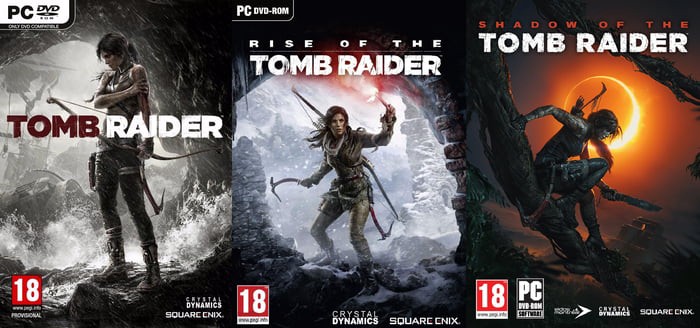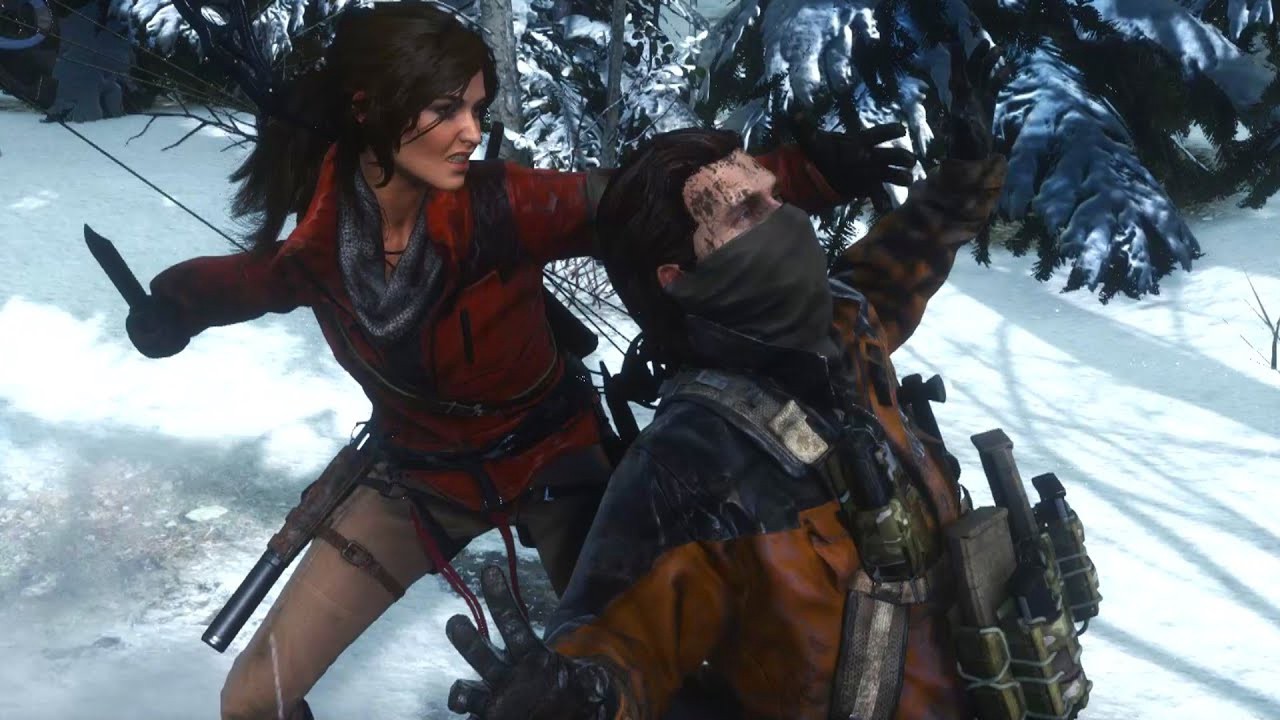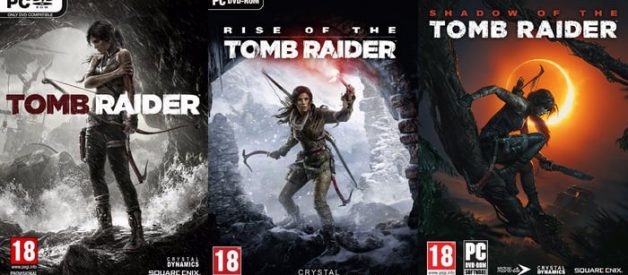The OG Tomb Raider games made their mark on the video game industry for being big innovators in the action-adventure ?genre? of games as well as creating one of the most recognizable video game characters of all time in Lara Croft. The franchise had new life breathed into it when Square Enix decided to reboot the series with a trilogy covering Lara Croft?s origin story, beginning with Tomb Raider in 2013 and finishing with Shadow of the Tomb Raider in 2018. So I actually played all three games in the trilogy, and so this review is going to cover all of them, as I figured the games weren?t too different from each other to warrant writing separate reviews for each title (which is also an indication that the games are at the very least decent, because I actually finished the trilogy).
 The three games in the rebooted Tomb Raider trilogy.
The three games in the rebooted Tomb Raider trilogy.
The trilogy basically covers the beginnings of how Lara Croft becomes the famous ?tomb raider? most people recognize her as as well as her struggle to fill her father?s shoes and combat the evil organization Trinity that always seems to be coming after her. In the first game, Lara and her crew get shipwrecked on an island and she has to help herself and the surviving members escape. In the second, she continues her father?s work to try and discover the truth about a mysterious religious prophet before Trinity gets to it first, and in the final game Lara travels to South America to try and prevent a global natural disaster, while once again fighting Trinity. Each game tells a pretty self-contained story so from a storytelling perspective you?re not forced to play all three games, though it?s something I recommend anyways as the sequels do make a few references to previous titles.
The core game-play mechanics are pretty well established by the first game, and the sequels mainly just add some improvements to the formula rather than overhauling entire systems, going with a ?if it ain?t broke don?t fix it? mentality. The game-play is composed of several important features that you?ll see in all three games, which include combat with stealth elements, puzzle solving, and environmental traversal/exploration. Each game also features a progression system via skills and weapon upgrades, though the way the systems work vary a bit with each game. The game?s strengths really shine in the various tombs placed throughout the world, and I had a lot of fun trying to solve each tomb?s puzzles which I think are excellently designed. For the most part, they are challenging but usually not too bad to figure out, though I have to admit there were a few puzzles where I was genuinely stumped and ended up looking up some pointers on the Internet. Watching Lara go through the environment climbing walls and buildings is also really satisfying too, though it can be a bit immersion-breaking as Lara is performing almost superhuman feats of strength (that or she?s secretly a Ninja Warrior).
The combat is actually pretty decent as well, though not exactly ground-breaking or out-of-this-world good. It does its job and it?s fun enough that one can enjoy it casually without having to try too hard. The enemies aren?t bullet sponges (on Normal difficulty at least) and it?s not too hard to take out individual bad guys, but you have to take care to avoid being ganged up on as you?re no bullet sponge yourself. What actually makes the combat enjoyable for me though is the stealth mechanic, which is something that is more emphasized in the sequel titles. Since engaging in open combat with multiple enemies is actually dangerous, you?re encouraged to use the environment and learn the AI patterns so you can stealthily thin out the enemy ranks. You can stealth kill baddies, but you have to be careful to make sure no one?s around to witness you otherwise everyone else is alerted. Also, the AI reacts to their dead allies too, so if they see one of their buddies dead on the ground they?re going to go on alert. A lot of combat scenarios also give you random objects lying around that you can throw as a distraction or craft into more lethal weapons on the fly like molotovs.
 RIP this dude
RIP this dude
The progression system is a bit simplistic, which can be good or bad depending on your personal view point. On one hand due to its simplicity it may not feel as satisfying to level up, but at the same time it?s a lot easier to understand so you?re not spending a ton of time trying to figure out what to upgrade. That being said, there are quite a few cool skills for Lara to unlock so you?re encouraged to try and go for them. The later games in the trilogy do significantly improve progression by actually opening up various equipment customization options to you. In the second and third games, you?re not restricted to using specific gear and weapons and you?re free to choose what you want to equip, so there is more freedom. Some equipment gives you more experience from hunting animals, which is great if you?re looking for more animal-related materials, while others might give straight combat upgrades or improve your stealth capabilities.
I?m also a fan of the artistic design of the trilogy; I think a lot of the levels are beautifully designed and walking into a massive tomb can be almost breathtaking. The games also have a pretty visceral feeling to them (hence the 18+ rating), and Lara sometimes takes out her enemies in pretty brutal ways and it adds a sense of ?oomph? every time you get a kill. What?s a bit disturbing and funny at the same time is how the game handles the player dying, and some of Lara?s death animations can be really graphic (I?ve seen some scenes where I died due to failing a part of a puzzle and Lara just gets impaled on some spikes). From a technical perspective the games look really good graphically as well, and for the most part I?ve played through the games at a 60+ frame rate, though there were a few areas in the first/second games where the frame rate wasn?t as satisfactory (satisfactory in the sense that I should be getting 60+ frames with a GTX 1070 and an i5?8600k but I wasn?t).
So the trilogy is pretty fun to play, but how?s the story-telling? I personally found the writing for the trilogy overall to be adequate, though I think the story was definitely the strongest in the first game. I felt that Tomb Raider struck a good balance between mystery and suspense, and the stakes felt very real as Lara is undergoing a very real struggle to just make it out alive. The sequels are focused more on her fight against Trinity and trying to complete her father?s work, and they?re not badly written either but I just felt like the first game?s narrative was more tight and cohesive. The sequels introduce a lot of outside characters (especially the villains) that I feel like I should have been exposed to more so I could try to relate more to them and actually try to be invested in their stories. That said, I have a very positive opinion of the way the writers treated Lara and developed her character. She starts out as a curious, naive explorer who hasn?t experienced the harsh reality of the work she?s doing, as well as somebody who struggles with family issues due to the impact her father as left on her, and central themes in the games focus on her growing into the infamous tomb raider as well as escaping the shadow of her father. She?s not without her clear character flaws as well; she?s stubborn and tends to be tunnel-visioned on her goals which sometimes prevents her from recognizing the consequences her actions can have on the surrounding characters, and sometimes that ends up causing her even more problems which she?s forced to try and rectify. Lara?s characterization is further improved by her voice actress?s excellent work, and while her game-play abilities may not feel very human she definitely feels human as a written character. Overall the writing for the Tomb Raider trilogy feels like a good blockbuster; entertaining, action-packed with good character development but not mind-blowing phenomenal.
Aside from the writing being a bit weak at certain points, there are a few minor nitpicks I have with the games. There are a few situations in the games that feature game-play sequences that are inconsistent with the writing/lore, with two big examples being certain combat scenarios in the first game and some visual designs in the various puzzle sequences. In the first game, there are a good amount of combat sequences where you?re being attacked by a lot of goons and have to kill them all, which doesn?t really match the image they were trying to depict Lara as in the first game (a green archaeologist who hasn?t had that much experience with the outside world); in those moments you go from a scared girl just trying to find her friends and escape the island into a seasoned killer. While the combat sequences are obviously there for game-play entertainment reasons, I feel like they could?ve integrated them in a more consistent fashion. Another minor gripe is with the various rope arrow obstacles throughout the world. Now I think the rope arrow mechanic is absolutely cool, but why would there be newly tied rope for you to attach a rope arrow to in a tomb that?s been sealed off for hundreds if not thousands of years?
My biggest criticism of the trilogy is definitely more of a subjective opinion so take it with a grain of salt, but while overall I think the trilogy is great and entertaining, I do wish the developers took bolder steps with each sequel. I understand the ?don?t fix what ain?t broken? attitude, which isn?t a bad mindset, and aside from arguably the writing each game did technically improve from the last, but I felt like the sequels lacked any truly stand-out innovations from the first game; it sort of felt like playing one game followed by two big expansions rather than three separate games. However, on the other side of the coin, if you?re a big fan of how the overall package of the first game (and in my opinion it delivers really well), then maybe it?s not such a bad thing the sequels followed the same formula. If you?re a fan of action-adventure games and clever puzzle-solving, the Tomb Raider trilogy is not something to be missed.
Rating: The first game?s worth retail (goes for $20 on Steam), while the sequel games are worth getting on sale.


